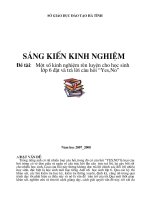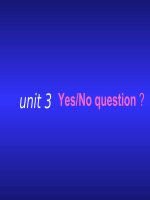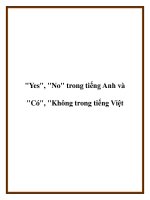yes no questions
Bạn đang xem bản rút gọn của tài liệu. Xem và tải ngay bản đầy đủ của tài liệu tại đây (1.03 MB, 20 trang )
In this section we will study about
A. KINDS OF QUESTIONS
1.Yes-No Questions
2.Question tag
3.Question-Word-Questions
B. GERUNDS
C. ENOUGH & TOO
A . K I N D S O F Q U E ST I O N S
1.Yes-No Questions
MAKING YES-NO QUESTIONS
Positive sentences can be changed into Yes-No Questions.
Steps to change positive sentences into Yes-no questions:
1.
Move to be (is, am, are) and to do (do, does, did) to the beginning of the sentence.
2.
Change subject(s) to pronoun.
3.
Put the rest of the sentence and add a question mark (?).
There are 5 pronouns that must be changed if we make yes-no questions
from positive sentence :
Positive Sentence (+) Yes-no questions (?)
1.
I am........................
Am I...................?
2.
You are …................
Are you.........................?
3.
She is ………..............
Is She.....................?
4.
She learns English...
Does she.....................?
5.
You and I are..........
Are we.......................?
6.
I speak English……….
Do I………………………?
Example :
Jane is a nurse
Is she a nurse?
Tom and Tim are students
Are they students?
The cat is black
Is it black?
James learns English
Does James learn English?
I learn English
Do I learn English?
EXERCISES
Make yes-no questions from the sentences
1.
The girl is Alice. Is she Alice?
2.
We are students in England.
3.
They are pens for the teacher.
4.
This is a ship.
5.
Ann and I are fine.
6.
You and Edward are drivers.
7.
The class is big.
8.
The dog and the cat are black.
9.
The nurse speaks to the parents.
10.
We like the food in the restaurant.
11.
The tall boy talks to mother.
12.
The teacher teaches the students well.
13.
Tom and you read the story.
14.
James drinks coffee and eat the bread.
15.
The cities are ugly.
16.
The car is long and white.
17.
The country is beautiful and interesting.
18.
The short letters are on the table.
19.
You are from United States.
20. The cat drinks the water on the plate.
2. Question tag
Question tags is a short addition
after a sentence to express
agreement or stress. In Bahasa we
use the word “bukan”.
Steps in making question tags:
1.
If the sentence is positive, add the negative
question.
Example :
a)
b)
c)
d)
e)
Jane comes late, doesn’t she?
The nurse is helping them, isn’t she?
Susan will do it, won’t she?
The dog has bitten you, hasn’t it?
There were some flowers on the table, weren’t there?
2. If the sentence is negative, add the positive question.
Example:
a.
The driver didn’t know the address, did he?
b.
They can’t see the match, can they?
c.
Father oughtn’t to stay there, ought he?
d.
The girls haven’t to buy dresses, have they?
e.
The nurses aren’t kind, are they?
Notes:
a. Positive sentence using am is followed by aren’t I?
Example :
I am early, aren’t I?
I am with you, aren’t I?
But
I am not a driver, am I?
I am not sick, am I?
b. Subject of a question tag is always a pronoun
Example:
Bob could not go there, could he?
The nurses have done it, haven’t they?
c. The sentence which have the components such as neither, no(adj), none, no one,
nobody, nothing, scarcely, barely, hardly, hardly ever, seldom, never, is
considered as negative sentence, so it is followed by positive question.
Example:
I have no cars, do I?
Peter hardly ever goes to parties, does he?
d. Not is always written : n’t (except won’t, shan’t)
Example:
Tom will come, won’t he?
I shall do it, shan’t I?
The boy likes the kite, doesn’t he
e. If the subject is no one, any, some, every, neither, none. The
pronoun is they.
Example:
None of the bottles are broken, are they?
Neither of them complained, did they?
Everyone warned you, didn’t they?
Someone will help, won’t they?
f. Let’s is followed by question tag shall we.
Example:
- Let’s go, shall we?
EXERCISES
Add the questin tags!
1.
Father saw no one there.
2.
The child can’t eat it.
3.
Nobody has found them.
4.
The small cat doesn’t eat fish.
5.
Neither of them will do it.
6.
The drivers have time.
7.
You knew that.
8.
The girl plays well.
9.
Susan used to live here.
10.
I was right.
11.
No one will agree with you.
12.
You won’t be long.
13.
The teacher didn’t find it.
14.
The students must pay it.
15.
I hardly play cards.
16.
The woman doesn’t know you.
17.
I needn’t say anything.
18.
You won’t tell anyone.
19.
The dress isn’t expensive.
20. Somebody has taken my pen.
ANSWERING QUESTION TAGS
1. Positive Statements.
Positive statement and nenegative question tag:
a. If we agree with the positive statement, we answer Yes
Example: The world is round, isn’t it?
Yes, it is. (agree)
b. If we disagree with the positive statement, we answer No.
Example: The fire looks cold, doesn’t it?
No, it doesn’t. (disagree)
2. Negative Statements
Negative statement and positive question tag:
a. If we agree with the positive statement, we answer No.
Example:
Water doesn’t boil at 50° C, does it?
No, it doesn’t. (agree)
b. If we disagree with the positive statement, we answer Yes.
Example:
The World War One didn’t end in 1919, did it?
Yes, it did. (disagree)









